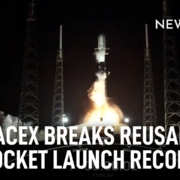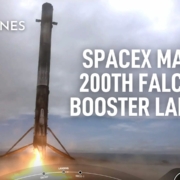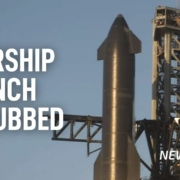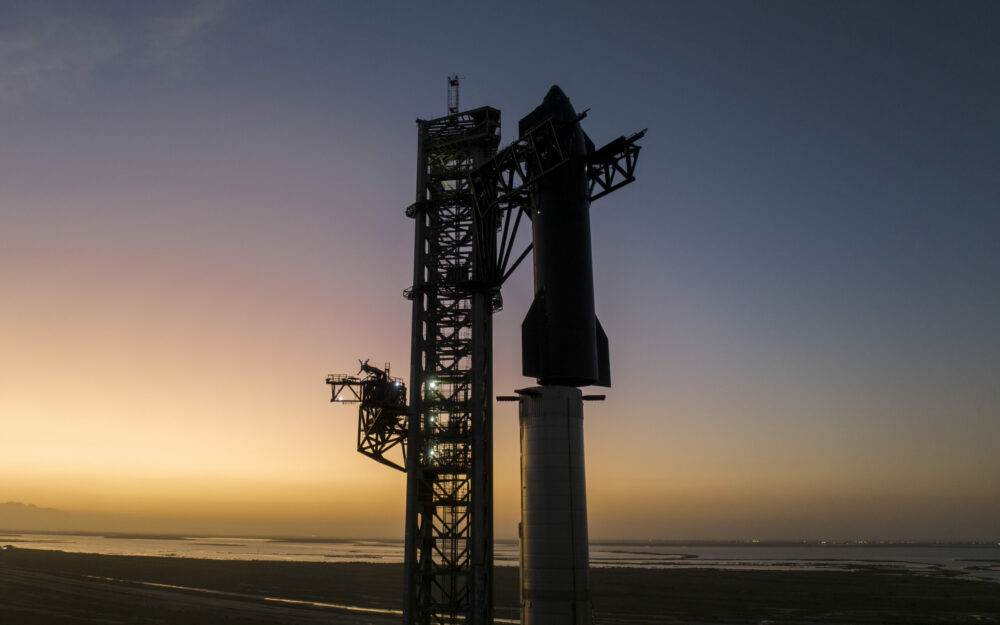Starship 6 Test
SpaceX conducts its sixth test of Super Heavy booster (Booster 13) and Starship (Ship 31) at Starbase, Texas. The test focusses on operational improvements, including experiments with the heat shield, flying the spacecraft at a steeper reentry angle to gather data on thermal protection system performance. The flight carried a banana as payload. After a successful launch and hot-stage separation, the Booster was diverted to splashdown in the Gulf of Mexico instead of being caught by the Mechazilla arms. Ship 31 reignited one of its Raptor engines in space, and after a flight of 1hr 5 mins completed its splashdown in the Indian Ocean. Musk:
Successful ocean landing of Starship! We will do one more ocean landing of the ship. If that goes well, then SpaceX will attempt to catch the ship with the tower.
Successful ocean landing of Starship!
We will do one more ocean landing of the ship. If that goes well, then SpaceX will attempt to catch the ship with the tower. https://t.co/osFud7XXPo
— Elon Musk (@elonmusk) November 20, 2024
Starship Test 5: Mechazilla arms catch Booster
For its fifth flight test, Starship, consisting of the Super Heavy booster (Booster 12) – powered by 33 Raptor engines – and the Starship spacecraft (Ship 30), lifts off from Boca Chica, Texas. At 2m 40s the Super Heavy booster separates from the Starship spacecraft (Ship 30) using hot-staging. Post-separation, the Super Heavy ascends to 69 km (43 miles) and then executes a boostback burn to reverse its course and return towards the launch site, where it slides horizontally into the Mechazilla launch tower’s 30m “chopstick” arms, completing the first successful Heavy Booster catch.
Meanwhile, Starship continues its suborbital trajectory, reaching an apogee of about 212 km (132 miles) over the Indian Ocean. Despite damage to one of its control flaps, Starship maintains stability using its flaps through re-entry to splashdown in the Indian Ocean, approximately 7,000 km (4,350 miles) from separation. Musk:
Even rockets need hugs
Even rockets need hugs 🥰 pic.twitter.com/oF36F0AvBf
— Elon Musk (@elonmusk) October 14, 2024
Starship Test 4: Succesful splashdowns
SpaxeX conducts the fourth flight test of Starship, comprising the Starship Ship 29 upper-stage and Super Heavy Booster 11. The test successfully achieved its two main objectives: simulate a landing with the Super Heavy booster near the surface of the Gulf of Mexico, and ensure Starship could survive peak heating during atmospheric re-entry. Despite minor engine issues, the flight was considered a success, with successful spashdowns. The test was a step forward from the third test, where both stages were destroyed upon re-entry. Modifications included upgrades to the oxygen tanks for better propellant filtration, enhancements to the Raptor engines for improved reliability, and additional roll control thrusters on the ship. The mission profile omitted certain demonstrations from previous tests but included jettisoning the hot staging ring from the booster, a temporary measure for mass reduction during descent.
The FAA did not require a mishap investigation, a first for Starship flights, indicating that the flight stayed within the parameters of planned and authorized activities.
Musk gives high fives to the SpaceX team and his son, Lil X.
Watch Starship’s fourth flight test → https://t.co/bJFjLCiTbK https://t.co/SjpjscHoUB
— SpaceX (@SpaceX) June 6, 2024
SpaceX breaks reusable rocket launch record
SpaceX breaks its own record, after successfully completing a 16th mission with a reusable rocket. The company launches 22 Starlink satellites aboard the Falcon 9 rocket from the Space Force Station in Cape Canaveral, Florida. It is the 16th launch and landing for the B1058 Falcon 9 rocket booster. SpaceX says it hopes the booster can be used a further four times before finally being scrapped. There are now more than 4,000 active Starlink satellites in orbit around Earth, delivering high-speed internet to users. After the satellites are deployed, Musk writes on Twitter:
Looks like we can increase Raptor thrust by ~20 per cent to reach 9,000 tons (20 million lbs) of force at sea level… And deliver over 200 tons of payload to a useful orbit with full and rapid reusability. Fifty rockets flying every three days on average enables over a megaton of payload to orbit per year – enough to build a self-sustaining city on Mars.
200th Falcon 9 booster landing
In a rideshare mission called Transporter-8, SpaceX launches a Falcon 9 rocket containing 72 small satellites from California’s Vandenberg Space Force Base to orbit and lands the returning booster, eight minutes later, back on Earth, marking the 200th booster landing in SpaceX’s history. This is the ninth launch and landing for this particular booster. The rocket’s upper stage continued hauling aloft the 72 payloads, which included “cubesats, microsats, a re-entry capsule and orbital transfer vehicles carrying spacecraft to be deployed at a later time.” The satellites deployed from the Falcon 9’s upper stage, separate over a 24-minute span, beginning an hour after liftoff. Transporter-8 was SpaceX’s second mission in about 14 hours, the eighth small-satellite “rideshare” mission launched by SpaceX, and its third such flight of 2023.
After delivering 72 spacecraft to orbit, Falcon 9 returns to Earth and completes SpaceX’s 200th landing of an orbital class rocket pic.twitter.com/7Aw52C97jk
— SpaceX (@SpaceX) June 13, 2023
SpaceX launches 81st Starlink mission, lands booster at sea
SpaceX successfully launches a Falcon 9 rocket, carrying 56 Starlink spacecraft, from Cape Canaveral Space Force Station in Florida, returning it to Earth less than nine minutes later, landing on the SpaceX drone ship, Just Read the Instructions, in the Atlantic Ocean. This was the 11th launch and landing for this Falcon 9 first stage booster, while Starlink Group 5-9 marks the 81st operation Starlink mission, boosting the total number of Starlink satellites launched to more than 4,400.
Falcon 9’s first stage has landed on the Just Read the Instructions droneship pic.twitter.com/bYvC8sH9NX
— SpaceX (@SpaceX) May 14, 2023
FAA grounds Starship pending crash investigation
SpaceX’s Starship rockets are grounded by the Federal Aviation Administration, after the rocket exploded on Thursday morning, to investigate the failed launch. FAA statement:
An anomaly occurred during the ascent and prior to stage separation resulting in a loss of the vehicle. No injuries or public property damage have been reported. The FAA will oversee the mishap investigation of the Starship / Super Heavy test mission. A return to flight of the Starship / Super Heavy vehicle is based on the FAA determining that any system, process, or procedure related to the mishap does not affect public safety. This is standard practice for all mishap investigations. The FAA is responsible for protecting the public during commercial space transportation launch and reentry operations.
Starship launch debris covers Texas coast
SpaceX’s Starship rocket launch causes a massive debris field around the launch pad. The force of the rocket engines creates a crater under the concrete launch pad, sending debris away from the pad at thousands of miles an hour, causing damage to the nearby tank farm, a car parked miles away and forming a dust cloud that blocks out the sun over the Texas coast until strong winds blows it away. Video shows chunks of debris landing in the Gulf of Mexico.
Close up on the vast debris field created by the starship/superheavy launch. It's a crop from the video shot from starbase #SpaceX #StarshipLaunch pic.twitter.com/KYaloIFE7n
— MechDesign.xyz (@MechDesignxyz) April 20, 2023
Starship explodes four minutes into second test attempt
After being delayed from April 18, SpaceX makes a second attempt at launching Starship. After a short countdown hold at 40 seconds the spacecraft launches and clears the tower. Four minutes into the flight, at a height of 34km, the vehicle explodes, after the second stage fails to separate. Musk congratulates the team:
Congrats @SpaceX team on an exciting test launch of Starship! Learned a lot for next test launch in a few months.
Congrats @SpaceX team on an exciting test launch of Starship!
Learned a lot for next test launch in a few months. pic.twitter.com/gswdFut1dK
— Elon Musk (@elonmusk) April 20, 2023
Starship launch scrubbed
The first Starship launch is scrubbed, ten minutes before launch, due to a pressurant valve being frozen. The countdown continues as a ‘wet dress rehearsal’, to T minus 40 seconds. Another launch attempt may happen in the next 48 hours.
A pressurant valve appears to be frozen, so unless it starts operating soon, no launch today
— Elon Musk (@elonmusk) April 17, 2023
Starship launch rescheduled to Apr 20
SpaceX says it is targeting Thursday, April 20 for the first flight test of a fully integrated Starship and Super Heavy rocket from Starbase in Texas. The 62 minute launch window opens at 8:28 a.m. CT and closes at 9:30 a.m. CT.
Teams are working towards Thursday, April 20 for the first flight test of a fully integrated Starship and Super Heavy rocket → https://t.co/bG5tsCUanp pic.twitter.com/umcqhJCGai
— SpaceX (@SpaceX) April 17, 2023
Musk ‘not saying’ Starship will get to orbit
SpaceX will debut its Starship vehicle in a month or so, but the chances of its first-ever orbital mission being a success are apparently only about 50%.
I’m not saying it will get to orbit, but I am guaranteeing excitement. So, won’t be boring!…So I think we’ve got, hopefully, about an 80% chance of reaching orbit this year. It’ll probably take us a couple more years to achieve full and rapid reusability.
According to Musk, Starship will be the most powerful rocket to ever fly, featuring about 2.5 times more thrust at liftoff than NASA’s Saturn V. SpaceX hopes that, among other things, Starship will get people and cargo to the moon and Mars. It is designed to be fully and rapidly reusable, which Musk considers the most important breakthrough for making Mars colonization and other ambitious exploration feats feasible.
Falcon Heavy double booster landing
The two side boosters from Falcon Heavy USSF-44 mission return to Earth safely, marking the 150th and 151st succesful orbital-class booster recovery. The middle booster was expended. The mission is to deploy two payloads for the US Space Force into geosynchronous orbit, one of which is the TETRA 1 microsatellite.
Falcon Heavy’s side boosters have landed – marking the 150th and 151st recovery of orbital class rockets pic.twitter.com/vK4ZdfDQtX
— SpaceX (@SpaceX) November 1, 2022
SpaceX fully stacks Starship rocket
For the first time in more than six months, SpaceX stacks both stages of Starship, creating the largest and most powerful launch vehicle ever fully assembled. SpaceX has conducted three other full-stack Starship demonstrations: in August 2021 and February and March 2022. This stack includes Super Heavy Booster 7 (B7) and Starship 24 (S24). The stacking is taking place at Starship’s orbital launch pad in Boca Chica, Texas.
After an aborted predawn attempt on October 11th, the Starship was lifted at sunset about 80 meters (250 ft) off the ground, translated over to Booster 7, and lowered on top of the 69-meter-tall (225 ft) first stage. After about two more hours of robotically tweaking their positions, the two Starship stages were secured together.
According to Musk, Booster 7 and Ship 24 will attempt Starship’s first full-stack wet dress rehearsal (WDR) once all is in order, which is a fully loaded countdown up to the point of launch.
Starship 24 and Booster 7 fully stacked on the orbital launch pad at Starbase pic.twitter.com/1VKn6juQor
— SpaceX (@SpaceX) October 12, 2022
Elon Musk
SpaceX Dragon Capsule docks with ISS
Elon Musk shares a video of the SpaceX Dragon capsule docking with the International Space Station. The docking took place 29 hours after the Falcon 9 spacecraft took off from Kennedy Space Center in Florida. SpaceX Crew-5 is the fifth crewed NASA flight, carrying two NASA astronauts, one Japanese astronaut and one Russian cosmonaut. During their time on the orbiting laboratory, the crew will conduct over 200 science experiments.
SpaceX Dragon docking with @Space_Station (extended video) pic.twitter.com/AFBDKHddgI
— Elon Musk (@elonmusk) October 7, 2022
Falcon 9 launches 52 Starlink satellites to orbit
SpaceX launches 52 Starlink satellites to orbit, on a Falcon 9 rocket. The launch was SpaceX’s 43rd orbital mission this year. Viewers close by the launchpad witnessed Falcon 9’s first stage falling back to Earth for a soft landing atop the SpaceX droneship, A Shortfall of Gravitas, which was stationed in the Atlantic Ocean. The company has already sent nearly 3,400 Starlinks into space and has a plan to bring thousands more aloft.
Falcon 9 launches 52 Starlink satellites to orbit pic.twitter.com/A4eGu4lmz0
— SpaceX (@SpaceX) September 25, 2022











